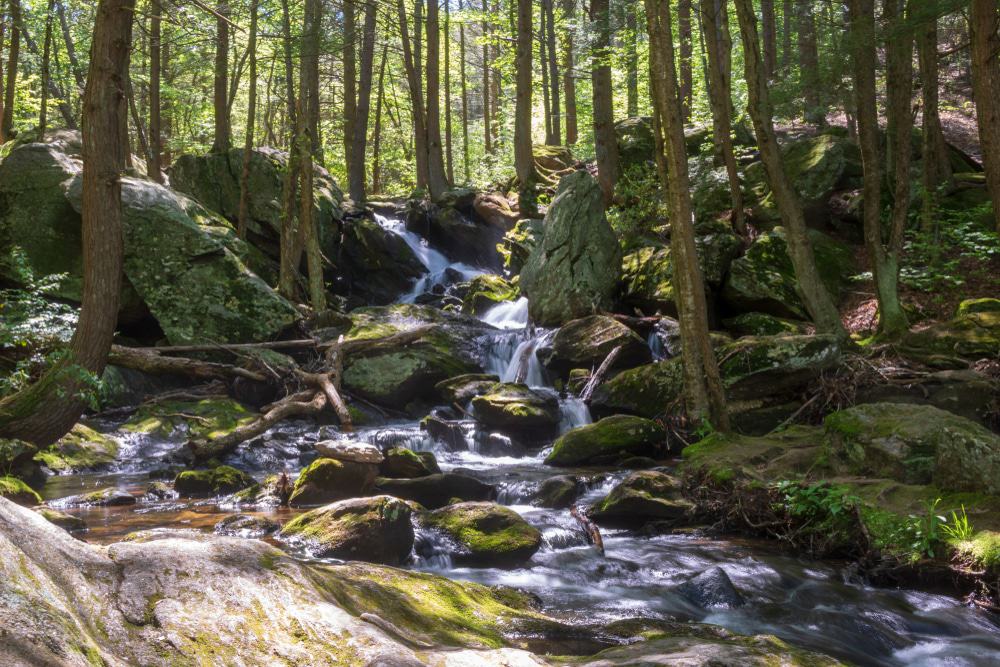Summary
- American Clock & Watch Museum
- Lock Museum of America
- Self-Guided Walking Tour of Plymouth Center
- Eli Terry Jr. Waterwheel
- Alley House Museum
- Toll House Museum
- Dorence Atwater Monument
- Railroad Museum of New England
- Mattatuck State Forest
- Buttermilk Falls
- Whitestone Cliffs Trail
- East Plymouth Historic District
- Terryville Lions Country Fair
- Black Rock State Park
- Lake Winfield Recreation Area
Located in Litchfield County and adjacent to the city of Bristol, Plymouth may appear to be a modest town today, yet it has significantly influenced the history of American manufacturing.
Plymouth was originally settled in 1720 on territory acquired from the Tunxis Indians.
By the late 18th century, Eli Terry commenced a clockmaking enterprise that would transform the industry by introducing mass production for the first time.
His three sons followed in his footsteps, and one son, Eli Terry Jr., expanded into lock-making.
He founded the Eagle Lock Company, which dominated the global lock market for many decades.
There are museums dedicated to both crafts, located here and nearby in Bristol, along with intriguing remnants of the past in the Terryville area.
Let us delve into the top attractions in and around Plymouth, Connecticut:
1. American Clock & Watch Museum

This location, situated just a few minutes away in Bristol, highlights a key aspect of Plymouth’s heritage at the historical core of the American clockmaking trade.
The museum serves as the foremost resource on this subject and is noted for its complex of historic homes, including the 1728 Barnes Homestead.
Within eight galleries, the American Clock & Watch Museum focuses on Eli Terry (1772-1852), who established his workshop in Plymouth’s Greystone section and pioneered mass-production techniques in clockmaking, including the introduction of interchangeable components.
The exhibits feature clocks and timepieces from various eras and regions, with particular emphasis on the Bristol-Waterbury area.
Regardless of your visit, aim to be present on the hour when all the timepieces chime simultaneously.
2. Lock Museum of America

This museum in Terryville unveils another historical cornerstone of Plymouth’s economy.
Terryville was named after Eli Terry Jr., who founded the Eagle Lock Company here in 1833. At its zenith, this enterprise was the largest trunk and cabinet manufacturer globally, and presently, approximately 45 years after the company ceased operations, four of the original 50 buildings remain standing.
Within the Lock Museum of America, a dedicated room features 1,000 Eagle locks produced between 1854 and 1954, alongside the Yale Room, which contains locks made by the renowned Yale brand from 1860 to 1950. A remarkable item on display is Linus Yale Jr.’s Mortise Cylinder Pin Tumbler Lock patent model from 1865. Additionally, the museum showcases safes, padlocks, door locks, safe locks, keys, historical time locks, and handcuffs sourced from around the globe.
The museum also offers an immersive escape room experience titled “Lock Museum Adventure.”
3. Self-Guided Walking Tour of Plymouth Center

Listed on the National Register of Historic Places in Connecticut, the village of Plymouth Center invites exploration on foot.
The Plymouth Historical Society organizes regular guided walks and provides a leaflet on its website for self-guided exploration.
This intriguing journey allows you to discover the graves of 38 Revolutionary War soldiers at the Burying Ground and ponder the symbolism behind their headstone carvings.
Notable sights include the Greek Revival Congregational Church (1838), featuring wooden clockworks crafted by Eli Terry, as well as the Old Plymouth Town Hall (1850), which now hosts an antiques store.
Other significant landmarks include a house formerly occupied by George Washington and a residence that was part of the Underground Railroad, serving as a network of safe houses for escaped African-American slaves in the early 19th century.
4. Eli Terry Jr. Waterwheel

A remarkable remnant from the lock-making era in Terryville is nestled along the western bank of the rapidly flowing Pequabuck River.
This structure is one of only three intact industrial waterwheels in Connecticut, likely dating back to 1851. Positioned in its original wheel well of rubblestone, the waterwheel consists of pressure-treated wood and iron, measuring 6.7 meters in diameter and 2.1 meters in width.
The historical significance of this waterwheel lies in the fact that it powered a factory responsible for producing millions of locks until 1940, when the remainder of this particular facility was demolished.
5. Alley House Museum

The primary office and museum for the Plymouth Historical Society is located in this Greek Revival house at 572 Main Street, which is open for meetings every last Saturday of the month at 1:00 PM, in addition to an open day in June and by appointment.
The Alley House, constructed in 1853, was built by prominent local businessman Augustus C. Shelton, a partner at the Shelton and Tuttle carriage shop, as a gift to his niece.
Inside, you can peruse an intriguing collection of Plymouth memorabilia, including a beautifully functioning Silas Hoadley grandfather clock from 1815.
6. Toll House Museum

Often overlooked from the road, this historic structure dates back to the early 19th century and occupies the same site.
This was the humble residence of the tollkeeper, who collected fees from travelers on the Hartford Turnpike, a frequently used route between Litchfield and Hartford.
Near the entrance, you will find a board listing the actual toll charges from 1834. The Toll House now features the restored Woodruff and Beach steam engine that powered the machinery at the Shelton & Tuttle Carriage factory beginning in 1852. Visitors can see this remarkable piece of industrial history in operation during the Open House in June.
7. Dorence Atwater Monument
This memorial honoring Plymouth’s war hero is located at Baldwin Park in Terryville.
Dorence Atwater (1845-1910) led a remarkable life, enlisting in the Union Army at the age of 16. He was captured early in the conflict and sent to the Confederate Army’s notorious prisoner-of-war camp at Andersonville, where he meticulously documented the deaths of many Union soldiers around him. This record allowed for the identification and marking of graves that would otherwise remain unmarked.
Post-war, after a brief incarceration under Andrew Johnson, he served as a consul in the Seychelles and later moved to Tahiti, where he married and established a successful shipping company while aiding lepers. He is fondly remembered as “Tupuuataroa” (Wise Man). Atwater lived long enough to see the cannon and plaque placed in his honor in 1907, alongside a pair of modern interpretive boards.
8. Railroad Museum of New England

By taking Main Street towards the Naugatuck River, you can embark on a memorable train excursion at the Railroad Museum of New England.
The museum houses one of the most extensive collections of historical railroad equipment in the area while operating the Naugatuck Railroad.
This 20-mile heritage line was established in 1845 and subsequently leased to the New York, New Haven and Hartford Railroad.
After boarding a vintage carriage at the restored Thomaston Station, built in 1881, the train transports passengers alongside the Naugatuck River, through the Mattatuck State Forest, past historic brass mills, and across the top of the Thomaston Dam.
This train ride uniquely traverses a dam within the United States.
The line operates from March to December, providing special seasonal services such as the Pumpkin Patch Trains in the fall.
9. Mattatuck State Forest

This expansive state forest encompasses 20 distinct blocks covering a total of 4,673 acres, with portions located within and adjacent to Plymouth.
Overall, the forest is known for its intriguing topography, elevated overlooks, and the variety of wooded habitats.
The most accessible way to explore Mattatuck State Forest in Plymouth is via the Blue-Blazed trail, which connects several blocks over its 36-mile course traversing seven towns, including Plymouth.
In the section along the western bank of the Naugatuck River, visitors can hike to the Leatherman’s Cave.
This cave served as a shelter for the eccentric 19th-century vagabond known as the Leatherman, who followed an annual 365-mile loop through eastern New York and western Connecticut, dressed in a hefty leather suit and seeking refuge in caves like this one in Watertown.
10. Buttermilk Falls

By hiking the Mattatuck Trail located to the southeast of the state forest, you will come across a natural feature regarded as one of the highlights of the journey.
Alternatively, there is parking available nearby on Lane Hill Road, allowing you to reach the falls within minutes while passing by a pair of caves nestled in the overhangs along the path.
The waterfall, shrouded by vibrant hemlock woodland, is best appreciated from its base, where a careful descent over the rocks is required to experience its entirety.
With a total drop of 16.7 meters, Buttermilk Falls consists of horsetails, slides, and cascades, all cloaked in moss-covered rocks, ferns, and wildflowers that bloom during spring.
11. Whitestone Cliffs Trail

The Whitestone Cliffs Trail stretches for just 1.7 miles, providing a brief yet picturesque Blue-Blazed loop through a section of the Mattatuck State Forest located in southern Plymouth.
The trail’s name is derived from the distinctive pale cliffs along the route, which are conspicuous from Connecticut Route 8 and the Naugatuck River.
During the course of this 1.7-mile trek, you will navigate rocky knolls, cross wetlands and streams, and ascend to an overlook that offers stunning views of the Naugatuck Valley.
12. East Plymouth Historic District

Now recognized as East Plymouth, this area at the intersection of East Plymouth Road and Marsh Road was settled after the Revolutionary War and is included in the National Register of Historic Places due to its rich architectural heritage from the early to mid-19th century.
The architecture in this district typically reflects Federal and Greek Revival styles, and a notable older structure is St. Matthew’s Church (1792), one of the oldest Episcopal churches in Connecticut, which has been converted into a unique residence.
The district showcases vernacular architectural styles prevalent in what was historically a modest village in rural Connecticut.
13. Terryville Lions Country Fair

Every year, from Friday to Sunday on the fourth weekend of August, the Terryville Lions Country Fair is organized for the local Lions Club.
This extensive fair offers diverse activities appealing to visitors of all ages.
Highlights include tractor pulling, farm animals, nostalgic carnival games, amusement rides, live music, various children’s activities, an “ATV rodeo,” a demolition derby, logging demonstrations, and much more.
The Plymouth Historical Society participates annually with exhibits showcasing historic tools, machinery, and souvenirs.
14. Black Rock State Park

Crossing the Naugatuck River, you will enter the unofficial region known as the Western Highlands, characterized by its elevated rolling hills.
Within just five minutes from Plymouth Center, you can access the parking area for Black Rock State Park, named for its notable sheer rock face.
From the summit of Black Rock, visitors can relish in picturesque views encompassing Thomaston, Watertown, and parts of Waterbury.
At Black Rock Pond, visitors can engage in swimming during the summer months and fishing. Additionally, there is a campground on-site featuring 78 campsites.
15. Lake Winfield Recreation Area

This beloved summer destination in Plymouth had experienced a decline by the 2000s; however, recent cleanup efforts over the past five years have revitalized Lake Winfield.
The slender lake extends approximately half a kilometer in length and is surrounded by a town park featuring a walking trail, tennis courts, a boat launch, a children’s playground, and a newly restored beach area.
New benches have been installed along the scenic waterside path, and a concession stand operates during the summer months.




